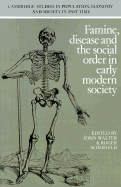Book contents
- Frontmatter
- Contents
- List of contributors
- List of figures
- List of tables
- Andrew Appleby: A personal appreciation
- A bibliography of Andrew B. Appleby's principal works in chronological order
- List of abbreviations
- 1 Famine, disease and crisis mortality in early modern society
- 2 The social economy of dearth in early modern England
- 3 Death in Whickham
- 4 The response to plague in early modern England: public policies and their consequences
- 5 Demographic crises and subsistence crises in France, 1650-1725
- 6 Markets and mortality in France, 1600–1789
- 7 Some reflections on corn yields and prices in pre-industrial economies
- 8 Family structure, demographic behaviour, and economic growth
- Consolidated bibliography
- Index
- Cambridge Studies in Population, Economy and Society in Past Time
4 - The response to plague in early modern England: public policies and their consequences
Published online by Cambridge University Press: 01 June 2011
- Frontmatter
- Contents
- List of contributors
- List of figures
- List of tables
- Andrew Appleby: A personal appreciation
- A bibliography of Andrew B. Appleby's principal works in chronological order
- List of abbreviations
- 1 Famine, disease and crisis mortality in early modern society
- 2 The social economy of dearth in early modern England
- 3 Death in Whickham
- 4 The response to plague in early modern England: public policies and their consequences
- 5 Demographic crises and subsistence crises in France, 1650-1725
- 6 Markets and mortality in France, 1600–1789
- 7 Some reflections on corn yields and prices in pre-industrial economies
- 8 Family structure, demographic behaviour, and economic growth
- Consolidated bibliography
- Index
- Cambridge Studies in Population, Economy and Society in Past Time
Summary
We may keep our Shipping to strict Quarantaine, we may form Lines, and cut off all Communication with the Infected, we may barricadoe up our Cities and our Towns, and shut ourselves up in our Houses, Death will come up into our Windows, and enter into our Palaces, and cut off our Children from without, and the young Men from the Streets.
William Hendley, Loimologia Sacra, 1721As it turned out, William Hendley was wrong. Death in the form of plague did not return to England during the 1720s, despite the scares aroused by its savage attack on Marseilles and other parts of southern France. Yet his profound scepticism about the policies adopted to control plague in England was widely shared; and it had been voiced by critical observers ever since those policies began in the sixteenth century. For quarantine had plainly not always protected England from the import of infection from the continent. Neither had strict watches against goods and travellers from London, when there were visitations there, prevented epidemics in provincial towns. The enforced isolation of infected families in their own houses, with their doors nailed up and guards outside them, had similarly failed to stop the movement of plague from household to household in stricken cities. Indeed, many critics had argued, such measures could not be expected to work.
- Type
- Chapter
- Information
- Famine, Disease and the Social Order in Early Modern Society , pp. 167 - 188Publisher: Cambridge University PressPrint publication year: 1989
- 5
- Cited by



